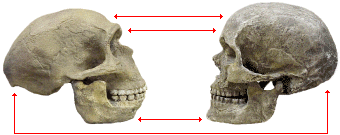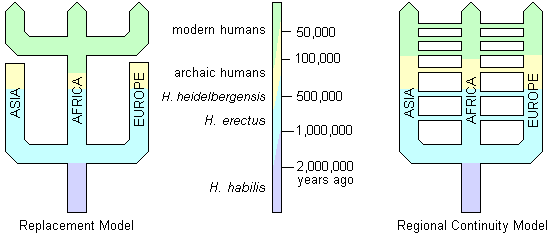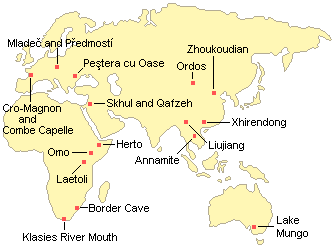Early Modern Homo sapiens
All
people today are classified as Homo sapiens.
Our species of humans
first began to evolve nearly
200,000 years
ago in association with technologies not unlike those of the
early Neandertals. It is now clear that early Homo
sapiens, or modern humans, did not come after the Neandertals
but were their contemporaries. However, it is likely
that both modern humans and Neandertals descended from Homo
heidelbergensis.
Compared to the Neandertals and other late archaic humans, modern humans generally have more delicate skeletons. Their skulls are more rounded and their brow ridges generally protrude much less. They rarely have the occipital buns found on the back of Neandertal skulls. They also have relatively high foreheads, smaller faces, and pointed chins.
 |
|
| Neandertal | modern Homo sapiens |
The first fossils of
early modern humans to be identified were found in
1868 at the 27,000-23,000 year old
Cro-Magnon rock shelter site near the village of Les Eyzies
![]() in
southwestern France. They were subsequently named the
Cro-Magnon
in
southwestern France. They were subsequently named the
Cro-Magnon
![]() people. They were very similar in appearance to modern Europeans.
Males were 5 feet 4 inches to 6
feet tall (1.6-1.8 m.) That was 4-12 inches (10-31
cm.) taller than Neandertals. Their skeletons
and musculature generally were less massive
than the Neandertals. The Cro-Magnon had broad, small faces with pointed
chins and high foreheads. Their cranial capacities were up to 1590
cm3,
which is relatively large even for people today.
people. They were very similar in appearance to modern Europeans.
Males were 5 feet 4 inches to 6
feet tall (1.6-1.8 m.) That was 4-12 inches (10-31
cm.) taller than Neandertals. Their skeletons
and musculature generally were less massive
than the Neandertals. The Cro-Magnon had broad, small faces with pointed
chins and high foreheads. Their cranial capacities were up to 1590
cm3,
which is relatively large even for people today.
Origins
of Modern Humans
Current data suggest that modern humans evolved from archaic humans primarily in East Africa. A 195,000 year old fossil from the Omo 1 site in Ethiopia shows the beginnings of the skull changes that we associate with modern people, including a rounded skull case and possibly a projecting chin. A 160,000 year old skull from the Herto site in the Middle Awash area of Ethiopia also seems to be at the early stages of this transition. It had the rounded skull case but retained the large brow ridges of archaic humans. Somewhat more advanced transitional forms have been found at Laetoli in Tanzania dating to about 120,000 years ago. By 115,000 years ago, early modern humans had expanded their range to South Africa and into Southwest Asia (Israel) shortly after 100,000 years ago. There is no reliable evidence of modern humans elsewhere in the Old World until 60,000-40,000 years ago, during a short temperate period in the midst of the last ice age.
|
Important Early Modern Homo sapiens Sites |
|||||||||||||||||||||||||||||||||||||||||||||||||
|
|
|
||||||||||||||||||||||||||||||||||||||||||||||||
|
Note: Artifactual evidence
indicates that modern humans were in Europe by at
least 40,000 and possibly as early as 46,000 years ago. Dating of the earliest modern human fossils in Asia is less secure, but it is likely that they were present there by at least 60,000 years ago and possibly 100,000 years ago. |
It would seem from these dates that the location of initial modern Homo sapiens evolution and the direction of their dispersion from that area is obvious. That is not the case. Since the early 1980's, there have been two leading contradictory models that attempt to explain modern human evolution--the replacement model and the regional continuity model.
The replacement model of Christopher Stringer and Peter Andrews proposes that modern humans evolved from archaic humans 200,000-150,000 years ago only in Africa and then some of them migrated into the rest of the Old World replacing all of the Neandertals and other late archaic humans beginning around 60,000-40,000 years ago or somewhat earlier. If this interpretation of the fossil record is correct, all people today share a relatively modern African ancestry. All other lines of humans that had descended from Homo erectus presumably became extinct. From this view, the regional anatomical differences that we now see among humans are recent developments--evolving mostly in the last 40,000 years. This hypothesis is also referred to as the "out of Africa", "Noah's ark", and "African replacement" model.
The regional continuity model (or multiregional evolution model) advocated by Milford Wolpoff proposes that modern humans evolved more or less simultaneously in all major regions of the Old World from local archaic humans. For example, modern Chinese are seen as having evolved from Chinese archaic humans and ultimately from Chinese Homo erectus. This would mean that the Chinese and some other peoples in the Old World have great antiquity in place. Supporters of this model believe that the ultimate common ancestor of all modern people was an early Homo erectus in Africa who lived at least 1.8 million years ago. It is further suggested that since then there was sufficient gene flow between Europe, Africa, and Asia to prevent long-term reproductive isolation and the subsequent evolution of distinct regional species. It is argued that intermittent contact between people of these distant areas would have kept the human line a single species at any one time. However, regional varieties, or subspecies, of humans are expected to have existed.

Replacement Model Arguments
There are two sources of evidence supporting the replacement model--the fossil record and DNA. So far, the earliest finds of modern Homo sapiens skeletons come from Africa. They date to nearly 200,000 years ago on that continent. They appear in Southwest Asia around 100,000 years ago and elsewhere in the Old World by 60,000-40,000 years ago. Unless modern human remains dating to 200,000 years ago or earlier are found in Europe or East Asia, it would seem that the replacement model better explains the fossil data for those regions. However, the DNA data supporting a replacement are more problematical.
Beginning in the 1980's, Rebecca Cann,
at
the University of California, argued that the geographic region in which
modern people have lived the longest should have the greatest amount of
genetic diversity today. Through comparisons of mitochondrial
DNA sequences from living people throughout the world,
she concluded that Africa has
the greatest genetic diversity and, therefore, must be the homeland of all
modern humans. Assuming a specific,
constant rate of mutation, she further
concluded that the common ancestor of modern
people was a woman living about
200,000 years ago in Africa.
This supposed predecessor was dubbed "mitochondrial
Eve"
![]() .
More recent genetic research at the University of Chicago and Yale
University lends support to the replacement model. It has shown that
variations in the DNA of the Y chromosome and chromosome 12
also have the greatest diversity among Africans
today. John Relethford and other critics of
the replacement model have pointed out that Africa could have had the greatest
diversity in DNA simply because there were more people living there during
the last several hundred thousand years. This would
leave open the possibility that Africa was not necessarily the only homeland
of modern humans.
.
More recent genetic research at the University of Chicago and Yale
University lends support to the replacement model. It has shown that
variations in the DNA of the Y chromosome and chromosome 12
also have the greatest diversity among Africans
today. John Relethford and other critics of
the replacement model have pointed out that Africa could have had the greatest
diversity in DNA simply because there were more people living there during
the last several hundred thousand years. This would
leave open the possibility that Africa was not necessarily the only homeland
of modern humans.
Critics of the genetic argument for the replacement model also point out that the rate of mutation used for the "molecular clock" is not necessarily constant, which makes the 200,000 year date for "mitochondrial Eve" unreliable. The rate of inheritable mutations for a species or a population can vary due to a number of factors including generation time, the efficiency of DNA repair within cells, ambient temperature, and varying amounts of natural environmental mutagens. In addition, some kinds of DNA molecules are known to be more subject to mutation than others, resulting in faster mutation rates. This seems to be the case with the Y chromosome in human males.
Further criticism of the genetic argument for the replacement model has come from geneticists at Oxford University. They found that the human betaglobin gene is widely distributed in Asia but not in Africa. Since this gene is thought to have originated more than 200,000 years ago, it undercuts the claim that an African population of modern Homo sapiens replaced East Asian archaic humans less than 60,000 years ago.
Regional
Continuity Model Arguments
Fossil evidence also
is used to support the regional continuity model. Its advocates claim
that there has been a continuity of some anatomical traits from archaic
humans to modern humans in Europe and Asia. In other words, the
Asian and European physical characteristics have antiquity in these regions
going back over 100,000 years. They point to the fact that many
Europeans have relatively heavy brow ridges and a high
angle of their noses reminiscent of Neandertals.
Similarly, it is claimed that some Chinese facial characteristics can be seen in
an
Asian archaic human fossil from
Jinniushan
dating to 200,000 years ago. Like Homo
erectus, East Asians today commonly have
shovel-shaped incisors while
Africans and Europeans rarely do. This supports the contention of direct
genetic links between Asian Homo erectus and modern Asians. Alan
Thorne of the Australian National University believes that Australian
aborigines
![]() share key skeletal and dental traits with pre-modern people who inhabited
Indonesia at least 100,000 years ago. The
implication is that there was no replacement by modern humans from Africa
60,000-40,000 years ago. However, the evidence does not rule out
gene flow from African populations to Europe and Asia at that time and before.
David Frayer, of the University of Kansas, believes that a number of European
fossils from the last 50,000 years have characteristics that are the result of
archaic and modern humans interbreeding.
share key skeletal and dental traits with pre-modern people who inhabited
Indonesia at least 100,000 years ago. The
implication is that there was no replacement by modern humans from Africa
60,000-40,000 years ago. However, the evidence does not rule out
gene flow from African populations to Europe and Asia at that time and before.
David Frayer, of the University of Kansas, believes that a number of European
fossils from the last 50,000 years have characteristics that are the result of
archaic and modern humans interbreeding.
Assimilation Model
It is apparent that both the complete replacement and the regional continuity models have difficulty accounting for all of the fossil and genetic data. What has emerged is a new hypothesis known as the assimilation (or partial replacement) model. It takes a middle ground and incorporates both of the old models. Gunter Brauer, of the University of Hamburg in Germany, proposes that the first modern humans did evolve in Africa, but when they migrated into other regions they did not simply replace existing human populations. Rather, they interbred to a limited degree with late archaic humans resulting in hybrid populations. In Europe, for instance, the first modern humans appear in the archaeological record rather suddenly around 45-40,000 years ago. The abruptness of the appearance of these Cro-Magnon people could be explained by their migrating into the region from Africa via an eastern Mediterranean coastal route. They apparently shared Europe with Neandertals for another 12,000 years or more. During this long time period, it is argued that interbreeding occurred and that the partially hybridized predominantly Cro-Magnon population ultimately became modern Europeans. In 2003, a discovery was made in a Romanian cave named Peştera cu Oase that supports this hypothesis. It was a partial skeleton of a 15-16 year old male Homo sapiens who lived about 30,000 years ago or a bit earlier. He had a mix of old and new anatomical features. The skull had characteristics of both modern and archaic humans. This could be explained as the result of interbreeding with Neandertals according to Erik Trinkaus of Washington University in St. Louis. Alan Templeton, also of Washington University, reported that a computer-based analysis of 10 different human DNA sequences indicates that there has been interbreeding between people living in Asia, Europe, and Africa for at least 600,000 years. This is consistent with the hypothesis that humans expanded again and again out of Africa and that these emigrants interbred with existing populations in Asia and Europe. It is also possible that migrations were not only in one direction--people could have migrated into Africa as well. If interbreeding occurred, it may have been a rare event. This is supported by the fact that most skeletons of Neandertals and Cro-Magnon people do not show hybrid characteristics.
|
Neandertals, and modern humans. This link takes you to another web page. To return here, you must click the "back" button on your browser program. (length = 51 mins, 32 secs) |
|
relationship between Neandertals and modern humans. This link takes you to another web page. To return here, you must click the "back" button on your browser program. (length = 17 mins, 2 secs) |
It would be a mistake to assume that from the time modern Homo sapiens began migrating out of Africa that all people in that continent were modern humans. The video below presents evidence of pockets of archaic humans surviving in West Africa until at least 13,000 years ago.
|
human skull from Nigeria. This link takes you to a BBC website. Select the video at the top of the article. To return here, you must click the "back" button on your browser program. (length = 1 min, 45 secs) |
Expansion
Out of the Old World
